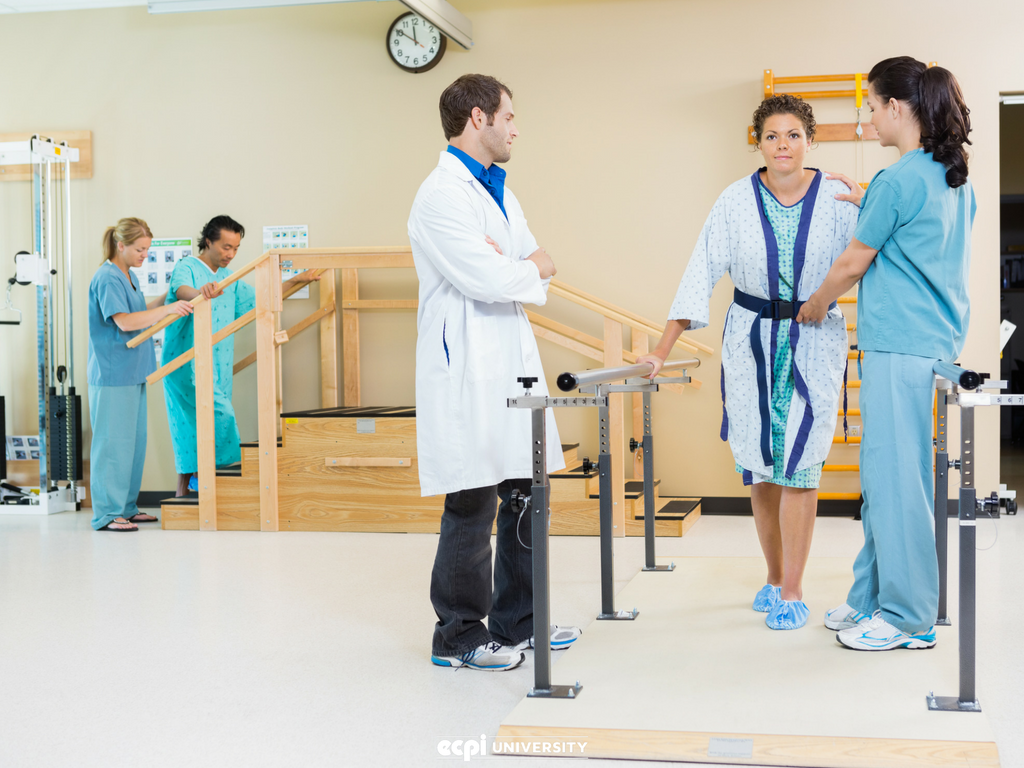Free Assistant Physiotherapist Course (1year Diploma Course)
Assistant Physiotherapist in the Healthcare Industry is also known as physical therapist assistant(PTA).
Brief Job Description:- Assistant Physiotherapist work alongside qualified physiotherapists, assisting in the rehabilitation of patients suffering from reduced mobility. Key tasks of a Assistant Physiotherapist include setting up equipment, preparing clients for therapy and demonstrating mobility aids and exercises. Other duties may include keeping the department tidy and basic administration work.
Personal Attributes:- Assistant Physiotherapist are required to be calm and patient. They should have an interest in health and physical education and carry a positive and motivating attitude. It is also important to have a good level of physical fitness and the ability to work well in a team. They are also required to be familiar with utilization of various equipment, rehabilitation or walking aids used during the treatment Assistant Physiotherapist Course.


The treatment plan as directed by the physiotherapist Assistant Physiotherapist Course:-
To be competent, the user/individual on the job must be able to:
PC1. Carry out physiotherapy assessment and treatment for patients
PC2. Deliver functional restoration programmes to individuals with muscular skeletal conditions and deliver health promotion programmes
PC3. Assist physical therapists in providing physical therapy treatments and procedures
PC4. Assist the physiotherapists in helping and treating people with physical problems caused by illness, accident or ageing
PC5. Carry out workplace assessments
Assist in patient mobility:-

To be competent, the user/individual on the job must be able to:
PC1. Assist the patient with walking, transfers and safe mobility
PC2. Help the patient in body movement
PC3. Help the patient with treatment related exercises
PC4. Transfer the patient safely and without injuries
Monitor and report changes in health status of patient to the supervisor Assistant Physiotherapist Course:-
To be competent, the user/individual on the job must be able to:
PC1. Work with registered physiotherapists in their day-to-day work
PC2. Help patients to follow exercise and treatment programmes set out by the physiotherapist
PC3. Write reports concerning patient’s status Assistant Physiotherapist Course.
PC4. Monitor change in patient heath and report to the supervisor

Provide patient/family education and support Assistant Physiotherapist Course:-
To be competent, the user/individual on the job must be able to:
PC1. Cultivate skill competence and engage in evidence-based practice, responding to the dynamics of a changing health care system
PC2. Provide support to the patients in treatment
PC3. Help family of the patient in awareness and support
Participate in program planning:-
To be competent, the user/individual on the job must be able to:
PC1. Actively participate in program planning
PC2. Achieve an effective transition from this educational program to a physical therapist assistant career
PC3. Commit to a lifelong process of self-improvement and learning
PC4. Cultivate skill competence and engage in evidence-based practice, responding to the dynamics of a changing health care system
Assist in providing occupational therapy Assistant Physiotherapist Course:-
To be competent, the user/individual on the job must be able to:
PC1. Observe patients while they perform tasks, ask the patient questions, and review the patient’s medical history
PC2. Use the observations, answers, and medical history to assist physiotherapist in evaluating the patient’s condition and needs
PC3. Assist in establishing a treatment plan for patients, laying out the types of activities and specific goals to be accomplished
PC4. Assist in evaluating a patient’s home or workplace activities and identify how it can be better suited to the patient’s health needs
PC5. Assist in educating a patient’s family and employer about how to accommodate and care for the patient PC6. teach anxiety management techniques;
PC7. assist people to return to work;
PC8. Submit and write reports for physiotherapist to plan and review on-going treatment


Communicating with individuals, patients, their family and others about health issues Assistant Physiotherapist Course:-
To be competent, the user/individual on the job must be able to:
PC1. Respond to queries and information needs of all individuals Assistant Physiotherapist Course.
PC2. Communicate effectively with all individuals regardless of age, caste, gender, community or other characteristics
PC3. Communicate with individuals at a pace and level fitting their understanding, without using terminology unfamiliar to them
PC4. Utilise all training and information at one’s disposal to provide relevant information to the individual
PC5. Confirm that the needs of the individual have been met
PC6. Adhere to guidelines provided by one’s organisation or regulatory body relating to confidentiality PC7. Respect the individual’s need for privacy
PC8. Maintain any recordsrequired at the end of the interaction
Act within the limits of one’s competence and authority:-
To be competent, the user/individual on the job must be able to:
PC1. Adhere to legislation, protocols and guidelines relevant to one’s role and field of practice
PC2. Work within organisational systems and requirements as appropriate to one’s role
PC3. Recognise the boundary of one’s role and responsibility and seek supervision when situations are beyond one’s competence and authority
PC4. Maintain competence within one’s role and field of practice Assistant Physiotherapist Course.
PC5. Use relevant research based protocols and guidelines as evidence to inform one’s practice
PC6. Promote and demonstrate good practice as an individual and as a team member at all times
PC7. Identify and manage potential and actual risks to the quality and safety of practice
PC8. Evaluate and reflect on the quality of one’s work and make continuing improvements


Work effectively with others:-

To be competent, the user/ individual on the job must be able to:
PC1. Communicate with other people clearly and effectively
PC2. Integrate one’s work with other people’s work effectively
PC3. Pass on essential information to other people on timely basis
PC4. Work in a way that shows respect for other people
PC5. Carry out any commitments made to other people
PC6. Reason out the failure to fulfil commitment
PC7. Identify any problems with team members and other people and take the initiative to solve these problems
PC8. Follow the organisation’s policies and procedures
Manage work to meet requirements:- To be competent, the user/ individual on the job must be able to: PC1. Clearly establish, agree, and record the work requirements
PC2. Utilise time effectively
PC3. Ensure his/her work meets the agreed requirements Assistant Physiotherapist Course.
PC4. Treat confidential information correctly
PC5. Work in line with the organisation’s procedures and policies and within the limits of his/her job role
Practice code of conduct while performing duties:-
To be competent, the user/individual on the job must be able to:
PC1. Adhere to protocols and guidelines relevant to the role and field of practice
PC2. Work within organisational systems and requirements as appropriate to the role
PC3. Recognise the boundary of the role and responsibility and seek supervision when situations are beyond the competence and authority
PC4. Maintain competence within the role and field of practice
PC5. Use protocols and guidelines relevant to the field of practice
PC6. Promote and demonstrate good practice as an individual and as a team member at all times
PC7. Identify and manage potential and actual risks to the quality and patient safety Assistant Physiotherapist Course.
PC8. Maintain personal hygiene and contribute actively to the healthcare ecosystem
Guidelinesfor Assessment:-
1. Criteria for assessment for each Qualification Pack will be created by the Sector Skill Council. Each Performance Criteria (PC) will be assigned marks proportional to itsimportance in NOS. SSC will also lay down proportion of marks for Theory and Skills Practical for each
PC 2. The assessment for the theory part will be based on knowledge bank of questions created by the
SSC 3. Individual assessment agencies will create unique question papersfor theory part for each candidate at each examination/training center (as per assessment criteria below)
4. Individual assessment agencies will create unique evaluationsforskill practical for every student at each examination/training center based on this criteria
5. To pass the Qualification Pack, every trainee should score as per assessment grid.
6. In case of successfully passing only certain number of NOS’s, the trainee is eligible to take subsequent assessment on the balance NOS’sto passthe Qualification Pack
treatment plan as directed by the physiotherapist:-
PC1. Carry out physiotherapy assessment and treatment for patients
PC2. Deliver functional restoration programmes to individuals with musculoskeletal conditions and deliver health promotion programmes
PC3. Assist physical therapists in providing physical therapy treatments and procedures
PC4. Assist the physiotherapists in helping and treating people with physical problems caused by illness, accident or ageing
PC5. Carry out workplace assessments
Assist in patient mobility:-
PC1. Assist the patient with walking, transfers and safe mobility
PC2. Help the patient in body movement
PC3. Help the patient with treatment related exercises
PC4. Transfer the patient safely and without injuries
Monitor and report changes in health status of patient to the supervisor:-
PC1. Work with registered physiotherapists in their day-to-day work
PC2. Help patients to follow exercise and treatment programmes set out by the physiotherapist
PC3. Write reports concerning patient’s status
PC4. Monitor change in patient heath and report to the supervisor Assistant Physiotherapist Course.
Provide patient/familyeducation and support:-
PC1. Cultivate skill competence and engage in evidence-based practice, responding to the dynamics of a changing health care system
PC2. Provide support to the patients in treatment
PC3. Help family of the patient in awareness and suppor
Participate in program planning:-
PC1. Actively participate in program planning
PC2. Achieve an effective transition from this educational program to a physical therapist assistant career
PC3. Commit to a lifelong process of selfimprovement and learning
PC4. Cultivate skill competence and engage in evidence-based practice, responding to the dynamics of a changing health care system
Assist in providing occupational therapy:-
PC1. Observe patients while they perform tasks, ask the patient questions, and review the patient’s medical history
PC2. Use the observations, answers, and medical history to assist physiotherapist in evaluating the patient’s condition and needs
PC3. Assist in establishing a treatment plan for patients, laying out the types of activities and specific goals to be accomplished
PC4. Assist in evaluating a patient’s home or workplace activities and identify how it can be better suited to the patient’s health needs
PC5. Assist in educating a patient’s family and employer about how to accommodate and care for the patient
PC6. Teach anxiety management techniques;
PC7. Assist people to return to work;
PC8. Submit and write reports for physiotherapist to plan and review on-going treatment

(Act within the limits of one’s competence and authority):-
PC1. Adhere to legislation, protocols and guidelines relevant to one’s role and field of practice
PC2. Work within organisational systems and requirements as appropriate to one’s role Assistant Physiotherapist Course.
PC3. Recognise the boundary of one’s role and responsibility and seek supervision when situations are beyond one’s competence and authority
PC4. Maintain competence within one’s role and field of practice
PC5. Use relevant research based protocols and guidelines as evidence to inform one’s practice
PC6. Promote and demonstrate good practice as an individual and as a team member at all times
PC7. Identify and manage potential and actual risks to the quality and safety of practice
PC8. Evaluate and reflect on the quality of one’s work and make continuing improvements
(Practice Code of conduct while performing duties):-
PC1. Adhere to protocols and guidelines relevant to the role and field of practice
PC2. Work within organisational systems and requirements as appropriate to the role
PC3. Recognise the boundary of the role and responsibility and seek supervision when situations are beyond the competence and authority
PC4. Maintain competence within the role and field of practice
PC5. Use protocols and guidelines relevant to the field of practice Assistant Physiotherapist Course.
PC6. Promote and demonstrate good practice as an individual and as a team member at all times
PC7. Identify and manage potential and actual risks to the quality and patient safety
PC8. Maintain personal hygiene and contribute actively to the healthcare ecosystem
(Manage work to meet requirements):-
PC1. Clearly establish, agree, and record the work requirements
PC1. Clearly establish, agree, and record the work requirements
PC3. Ensure his/her work meets the agreed requirements
PC4. Treat confidential information correctly
PC5. Work in line with the organisation’s procedures and policies and within the limits of his/her job role

(Collate and Communicate Health Information):-
PC1. Respond to queries and information needs of all individuals
PC2. Communicate effectively with all individuals regardless of age, caste, gender, community or other characteristics
PC3. Communicate with individuals at a pace and level fitting their understanding, without using terminology unfamiliar to them
PC4. Utilise all training and information at one’s disposal to provide relevant information to the individual
PC5. Confirm that the needs of the individual have been met
PC6. Adhere to guidelines provided by one’s organisation or regulatory body relating to confidentiality
PC7. Respect the individual’s need for privacy
PC8. Maintain any records required at the end of the interaction Assistant Physiotherapist Course.
(Work effectively with others):- PC1. Communicate with other people clearly and effectively
PC2. Integrate one’s work with other people’s work effectively
PC3. Pass on essential information to other people on timely basis
PC5. Carry out any commitments made to other people
PC6. Reason out the failure to fulfil commitment
PC7. Identify any problems with team members and other people and take the initiative to solve these problems
PC8. Follow the organisation’s policies and procedures
(Maintain a safe, healthy, and secure working environment):-
PC1. Identify individual responsibilities in relation to maintaining workplace health safety and security requirements
PC2. Comply with health, safety and security procedures for the workplace
PC3. Report any identified breaches in health, safety, and security procedures to the designated person
PC4. Identify potential hazards and breaches of safe work practices
PC5. Correct any hazards that individual can deal with safely, competently and within the limits of authority
PC6. Promptly and accurately report the hazards that individual is not allowed to deal with, to the relevant person and warn other people who may get affected
PC7. Follow the organisation’s emergency procedures promptly, calmly, and efficiently
PC8. Identify and recommend opportunities for improving health, safety, and security to the designated person
PC9. Complete any health and safety records legibly and accurately
Follow the treatment plan as directed by the physiotherapist:-
PC1. Carry out physiotherapy assessment and treatment for patients
PC2. Deliver functional restoration programmes to individuals with musculoskeletal conditions and deliver health promotion programmes
PC3. Assist physical therapists in providing physical therapy treatments and procedures
PC4. Assist the physiotherapists in helping and treating people with physical problems caused by illness, accident or ageing
PC5. Carry out workplace assessments
PC6. Promptly and accurately report the hazards that individual is not allowed to deal with, to the relevant person and warn other people who may get affected
PC7. Follow the organisation’s emergency procedures promptly, calmly, and efficiently
PC8. Identify and recommend opportunities for improving health, safety, and security to the designated person
PC9. Complete any health and safety records legibly and accurately
Follow the treatment plan as directed by the physiotherapist:-
PC1. Carry out physiotherapy assessment and treatment for patients
PC2. Deliver functional restoration programmes to individuals with musculoskeletal conditions and deliver health promotion programmes
PC3. Assist physical therapists in providing physical therapy treatments and procedures
PC4. Assist the physiotherapists in helping and treating people with physical problems caused by illness, accident or ageing
PC5. Carry out workplace assessments
Assist in patient mobility:-
PC1. Assist the patient with walking, transfers and safe mobility
PC2. Help the patient in body movement
PC3. Help the patient with treatment related exercises
PC4. Transfer the patient safely and without injuries

Monitor and report changes in health status of patient to the supervisor:-
PC1. Work with registered physiotherapists in their day-to-day work
PC2. Help patients to follow exercise and treatment programmes set out by the physiotherapist
PC3. Write reports concerning patient’s status
PC4. Monitor change in patient heath and report to the supervisor
Provide patient/family education and support:-
PC1. Cultivate skill competence and engage in evidence-based practice, responding to the dynamics of a changing health care system
PC2. Provide support to the patients in treatment
PC3. Help family of the patient in awareness and support
Participate in program planning
PC1. Actively participate in program planning
PC2. Achieve an effective transition from this educational program to a physical therapist assistant career
PC3. Commit to a lifelong process of selfimprovement and learning
PC4. Cultivate skill competence and engage in evidence-based practice, responding to the dynamics of a changing health care system

Assist in providing occupational therapy:-
PC1. Observe patients while they perform tasks, ask the patient questions, and review the patient’s medical history
PC2. Use the observations, answers, and medical history to assist physiotherapist in evaluating the patient’s condition and needs
PC3. Assist in establishing a treatment plan for patients, laying out the types of activities andspecific goals to be accomplished
PC4. Assist in evaluating a patient’s home or workplace activities and identify how it can be better suited to the patient’s health needs
PC5. Assist in educating a patient’s family and employer about how to accommodate and care for the patien
PC6. Teach anxiety management techniques;
PC7. Assist people to return to work
PC8. Submit and write reports for physiotherapist to plan and review on-going treatment
(Act within the limits of one’s competence and authority):-
PC1. Adhere to legislation, protocols and guidelines relevant to one’s role and field of practice
PC2. Work within organisational systems and requirements as appropriate to one’s role
PC3. Recognise the boundary of one’s role and responsibility and seek supervision when situations are beyond one’s competence and authority
PC4. Maintain competence within one’s role and field of practice
PC5. Use relevant research based protocols and guidelines as evidence to inform one’s practice
PC6. Promote and demonstrate good practice as an individual and as a team member at all times
PC7. Identify and manage potential and actual risks to the quality and safety of practice
PC8. Evaluate and reflect on the quality of one’s work and make continuing improvements
(Practice Code of conduct while performing duties):-
PC1. Adhere to protocols and guidelines relevant to the role and field of practice
PC2. Work within organisational systems and requirements as appropriate to the role
PC3. Recognise the boundary of the role and responsibility and seek supervision when situations are beyond the competence and authority
PC4. Maintain competence within the role and field of practice
PC5. Use protocols and guidelines relevant to the field of practice
PC6. Promote and demonstrate good practice as an individual and as a team member at all times
PC8. Maintain personal hygiene and contribute actively to the healthcare ecosystem Total
(Manage work to meet requirements):-
PC1. Clearly establish, agree, and record the work requirements
PC2. Utilise time effectively
PC3. Ensure his/her work meets the agreed requirements
PC4. Treat confidential information correctly
(Collate and Communicate Health Information):-
PC1. Respond to queries and information needs of all individuals
PC2. Communicate effectively with all individuals regardless of age, caste, gender, community or other characteristics
PC3. Communicate with individuals at a pace and level fitting their understanding, without using terminology unfamiliar to them
PC5. Confirm that the needs of the individual have been met
PC6. Adhere to guidelines provided by one’s organisation or regulatory body relating to confidentiality
PC7. Respect the individual’s need for privacy
PC8. Maintain any records required at the end of the interaction
(Work effectively with others):-
PC1. Communicate with other people clearly and effectively
PC2. Integrate one’s work with other people’s work effectively
PC3. Pass on essential information to other people on timely basis
PC4. Work in a way that shows respect for other people
PC5. Carry out any commitments made to other people
PC6. Reason out the failure to fulfil commitment
PC7. Identify any problems with team members and other people and take the initiative to solve these problems
PC8. Follow the organisation’s policies and procedure






